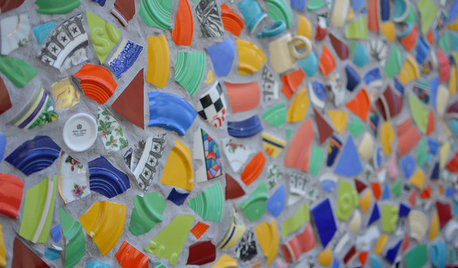Mosaic Virus -- any pictures available???
stevec
17 years ago
Related Stories

DECORATING GUIDESMosaic Tile Designs That’ll Thrill You to Bits
Whether you go for simple stones or imaginative expressions, a mosaic can turn any surface into a work of art
Full Story
DREAM SPACESDream Tile, Sensational Style
From intricate mosaics to large-scale porcelain, splurgeworthy tiles create a luxurious air in the bath and beyond
Full Story
KITCHEN DESIGNHouzz Quiz: Which Kitchen Backsplash Material Is Right for You?
With so many options available, see if we can help you narrow down the selection
Full Story
TILEHow to Choose the Right Tile Layout
Brick, stacked, mosaic and more — get to know the most popular tile layouts and see which one is best for your room
Full Story
KITCHEN DESIGN8 Top Tile Types for Your Kitchen Backsplash
Backsplash designs don't have to be set in stone; glass, mirror and mosaic tiles can create kitchen beauty in a range of styles
Full Story
BATHROOM DESIGN'Weave' Stone Tile for an Elegant Bath
Basketweave Mosaics Add Style and Dimension to a Tile Floor
Full Story
REMODELING GUIDESTerrazzo Makes a Comeback for Floors and More
Popular from the 1400s through the mid-1970s, this mosaic material is staging a return in homes today — including in some surprising uses
Full Story
KITCHEN DESIGNShow Us Your Compact Kitchen
Do you have a tiny kitchen that works well for you? Post your pictures in the Comments
Full Story
ART10 Things Artists Want You to Know
Inspiration, costs, commissioned work ... 5 artists share on these subjects to paint you a picture of the creative process
Full Story
MOST POPULARSummer Crops: How to Grow Sunflowers
Savor snack-tastic sunflower seeds once the radiant blooms have faded — if the birds have saved you any, that is
Full StoryMore Discussions






pitangadiego
erin_g
Related Professionals
Prairie Ridge Landscape Architects & Landscape Designers · Norwood Landscape Contractors · Fair Lawn Landscape Contractors · Morrisville Landscape Contractors · Newnan Landscape Contractors · Pacifica Landscape Contractors · South Farmingdale Landscape Contractors · Kingsburg Landscape Contractors · Golden Valley Landscape Contractors · Fort Lee Decks, Patios & Outdoor Enclosures · Kyle Decks, Patios & Outdoor Enclosures · Collierville Fence Contractors · Evanston Fence Contractors · Lake Forest Fence Contractors · North Potomac Fence Contractorsgorgi
gorgi
bjs496
gorgi
stevecOriginal Author
pitangadiego
axier - Z10, Basque Country (Spain)
mmlm
pitangadiego
rob5020
axier - Z10, Basque Country (Spain)